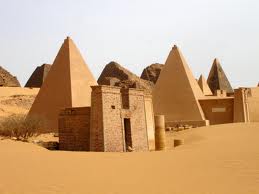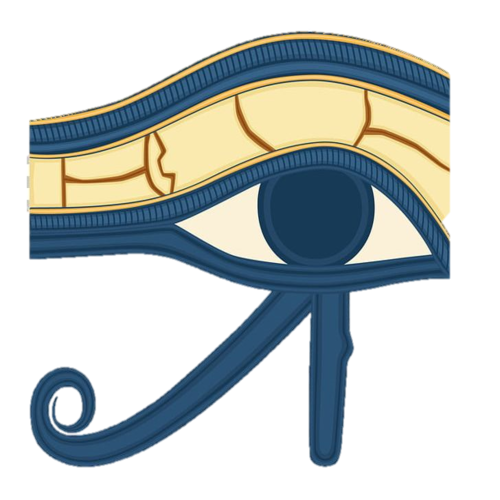
Meroë was a wealthy metropolis of the ancient kingdom of Kush in what is today the Republic of Sudan. The city was located at the crossroads of major trade routes and it flourished from 800 BCE to 350 CE. As no one yet has been able to decipher the Meroitic script, very little can be said for certain on how Meroe grew to become the wonderous city written about by Herodotus in circa 430 BCE, but it is known that the city was so famous for its wealth in ancient times that the Persian King Cambyses mounted an expedition to capture it (the expedition faltered long before reaching the city owing to the difficult and inhospitable terrain of the desert). The city was also known as the Island of Meroe as the waters flowing around it made it appear so.[1]
In 590 B.C.,an Egyptian army sacked Napata, compelling the Cushite court to move to a more secure location at Meroe near the sixth cataract. For several centuries thereafter, the Meroitic kingdom developed independently of Egypt, which passed successively under Persian, Greek, and, finally, Roman domination. During the height of its power in the second and third centuries B.C., Meroe extended over a region from the third cataract in the north to Sawba, near present-day Khartoum, in the south.
The pharaonic tradition persisted among a line of rulers at Meroe, who raised stelae to record the achievements of their reigns and erected pyramids to contain their tombs. These objects and the ruins of palaces, temples, and baths at Meroe attest to a centralized political system that employed artisans' skills and commanded the labor of a large work force. A well-managed irrigation system allowed the area to support a higher population density than was possible during later periods. By the first century B.C., the use of Hieroglyphs gave way to a Meroitic script that adapted the Egyptian writing system to an indigenous, Nubian-related language spoken later by the region's people. Meroe's succession system was not necessarily hereditary; the matriarchal royal family member deemed most worthy often became king. The queen mother's role in the selection process was crucial to a smooth succession. The crown appears to have passed from brother to brother (or sister) and only when no siblings remained from father to son.
Although Napata remained Meroe's religious center, northern Cush eventually fell into disorder as it came under pressure from the Blemmyes,

Artifact of Meroe
predatory nomads from east of the Nile. However, the Nile continued to give the region access to the Mediterranean world. Additionally, Meroe maintained contact with Arab and Indian traders along the Red Sea coast and incorporated Hellenistic and Hindu cultural influences into its daily life.[2] Inconclusive evidence suggests that metallurgical technology may have been transmitted westward across the savanna belt to West Africa from Meroe's iron smelteries.
Relations between Meroe and Egypt were not always peaceful. In 23 B.C., in response to Meroe's incursions into Upper Egypt, a Roman army moved south and razed Napata. The Roman commander quickly abandoned the area, however, as too poor to warrant colonization.
In the second century A.D., the Nobatae occupied the Nile's west bank in northern Cush. They are believed to have been one of several well-armed bands of horse- and camel-borne warriors who sold protection to the Meroitic population; eventually they intermarried and established themselves among the Meroitic people as a military aristocracy. Until nearly the fifth century, Rome subsidized the Nobatae and used Meroe as a buffer between Egypt and the Blemmyes. Meanwhile, the old Meroitic kingdom contracted because of the expansion of Axum, a powerful Abyssinian state in modern Ethiopia to the east. About A.D. 350, an Axumite army captured and destroyed Meroe city, ending the kingdom's independent existence.[3]
